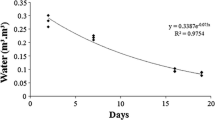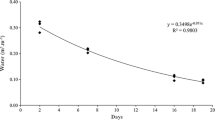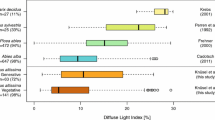Abstract
The prevailing paradigm of tree life histories emphasises strong interrelationships between growth, longevity and reproductive traits, attributing contrasting suites of correlated traits to ‘pioneer’ and ‘climax’ or ‘non-pioneer’ species. In tropical and southern temperate rainforests, although many of the species that require large gaps for regeneration conform to the expectations of small size and short lifespan, a number of others are long-lived canopy or emergent trees. Age data reported here for Weinmannia trichosperma, a shade-intolerant emergent tree in the temperate rainforests of southern Chile, indicate a maximum lifespan (>730 yr) exceeding those previously reported for any other angiosperm of the region. The long lifespan of W. trichosperma is associated with relatively slow growth, reflecting investment of resources in dense wood and possibly other defensive traits. Growth rates of W. trichosperma are much slower than those of associated short-lived pioneer trees, and apparently also slower than some of its more shade-tolerant associates. The light-demanding nature of many of the longest-lived trees in southern temperate forests highlights an important limitation of the classical pioneer-climax paradigm as a framework for understanding tree life history variation and modelling forest dynamics in this biome.
A longevity advantage over Nothofagus spp. may help explain the relative abundance of W. trichosperma in the lower to mid-elevation coast range forests in the Chilean lakes district, where the scarcity or absence of Nothofagus in many stands has been attributed to a low frequency of coarse-scale disturbance.p>
Similar content being viewed by others
References
Bazzaz, F. A. (1984) Dynamics of wet tropical forests and their species' strategies. Pp. 223–243. In: Medina, E., Mooney, H. A. & Vasquez, C. (eds), Physiological ecology of plants of the wet tropics. Dr W. Junk, The Hague, Netherlands.
Chapin, F. S., Bret-Harte, M. S., Hobbie, S. E. & Zhong, H. 1996. Plant functional types as predictors of arctic vegetation to global change. J. Veg. Sci. 7: 347–358.
Clark D. A. & Clark D. B. 1992. Life history diversity of canopy and emergent trees in a neotropical rain forest. Ecol. Monog. 62: 315–343.
Denslow, J. S. 1987. Tropical rainforest gaps and tree species diversity. Ann. Rev. Ecol. Syst. 18: 431–451.
Donoso, C. 1989a. —Antecedentes para la silvicultura del tipo forestal siempreverde. Bosque 10: 37–53.
Donoso, C. 1989b. —Regeneración y crecimiento en el tipo forestal siempreverde costero y andino tras distintos tratamientos silviculturales. Bosque 10: 69–83.
Duncan, R. P. 1989. An evaluation of errors in tree age estimates based on increment cores in kahikatea (Dacrycarpus dacrydioides). N.Z. Nat. Sci. 1: 31–37.
Enright, N. J. & Ogden, J. 1995. The Southern Conifers-A Synthesis. pp. 271–290. In: Enright, N. J. & Hill, R. S. (eds), Ecology of the Southern Conifers. Melbourne University Press, Australia.
Huston, M. & Smith, T. 1987. Plant succession: life history and competition. Am. Nat. 130: 168–198.
Kobe, R. K., Pacala, S. W., Silander, J. A. Jr, & Canham, C. D. 1995.Juvenile tree survivorship as a component of shade tolerance. Ecol. Appl. 5: 517–532.
Lara, A. 1991. The dynamics and disturbance regimes of Fitzroya cupressoides forests in the south-central Andes of Chile. Unpublished PhD thesis, University of Colorado, 183 pp.
Loehle, C. 1988. Tree life history strategies: the role of defenses. Can. J. Forest Res. 18: 209–222.
Lusk, C. H. 1996a. Gradient analysis and disturbance history of temperate rain forests of the coast range summit plateau, Valdivia, Chile. Rev. Chilena Historia Nat. 69: 401–411.
Lusk, C. H. 1996b. Stand dynamics of the shade-tolerant conifers Podocarpus nubigena and Saxegothaea conspicua in Chilean temperate rain forest. J. Veg. Sci. 7: 549–558.
MacArthur, R. H. & Wilson, E. O. 1967. The Theory of Island Biogeography. Princetown University Press, Princetown, New Jersey, Xi + 203 pp.
Marticorena, M. & Quezada, M. 1985. —Catálogo de la flora vascular de Chile. Guyana 42: 1–157.
Noble, I. R. & Slatyer, R. O. 1980. The use of vital attributes to predict successional changes in plant communities subject to recurrent disturbances. Vegetatio 43: 5–21.
Norton, D. A., Palmer, J. G. & Ogden, J. 1987. Dendroecological studies in New Zealand. 1. An evaluation of tree age estimates based on increment cores. New Zealand J. Bot. 25: 373–383.
Ogden, J. & Stewart, G. H. 1995. Community dynamics of the New Zealand conifers. Pp. 81–119. In: Enright, N. J. & Hill, R. S. (eds), Ecology of the Southern Conifers. Melbourne University Press, Australia.
Ogden, J., Fordham, R. H., Pilkington, S. & Serra, R. G. 1991. Forest gap formation and closure along an altitudinal transect in Tongariro National Park, New Zealand. J. Veg. Sci. 2: 165–172.
Perez, V. A. 1983. Manual de propiedades físicas y mecánicas de maderas chilenas. CONAF/FAO, Santiago, Chile, 451 pp.
Swaine, M. D. & Whitmore, T. C 1988. On the definition of ecological species groups in tropical rain forests. Vegetatio 75: 81–86.
Veblen, T. T. 1985. Forest development in tree-fall gaps in the temperate rain forests of Chile. Nat. Geog. Res. 1: 161–184.
Veblen, T. T. 1992. Regeneration dynamics. Pp. 153–187. In: Glenn-Lewin D. C., Peet, R. K. & Veblen, T. T. (eds), Plant Succession: Theory and prediction Chapman & Hall, London.
Veblen, T. T., Donoso, C., Schlegel, F. M. & Escobar, B. 1981. Forest dynamics in south-central Chile. J. Biog. 8: 211–247.
Veblen, T. T., Hill, R. S. & Read, J. 1996. The Ecology and Bio-geography of Nothofagus Forests. Yale University Press, New Haven.
Author information
Authors and Affiliations
Rights and permissions
About this article
Cite this article
Lusk, C.H. Long-lived light-demanding emergents in southern temperate forests: the case of Weinmannia trichosperma (Cunoniaceae) in Chile. Plant Ecology 140, 111–115 (1999). https://doi.org/10.1023/A:1009764705942
Issue Date:
DOI: https://doi.org/10.1023/A:1009764705942




